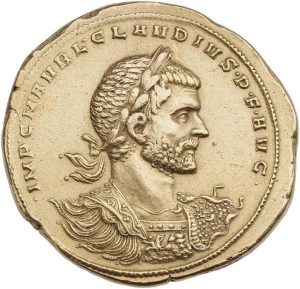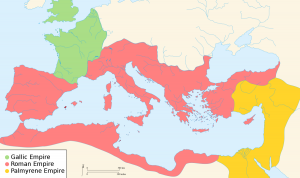| Claudius Gothicus | |
|---|---|
 |
|
| Roman Emperor | |
| In Power | 268-270 |
| Born | May 10, 214 Sirmium, Pannonia Inferior |
| Died | Jan/Apr 270 (aged 55) Sirmium |
Marcus Aurelius Claudius “Gothicus” was born on May 10, 214, in Pannonia Inferior, present-day Serbia. More popularly known as Claudius II, he served as a military tribune during the time of Decius.
Rise to Power
During the reign of Gallienus, invasions by barbarians and civil wars tormented the empire, along with a long-standing economic crisis. On top of these evils, a governor named Postumus had rebelled and established his territory in the provinces of Gaul and Britannia, which later became known as the Gallic Empire. Fearing that the empire was slowly weakening, a number of high-ranking officers conspired to kill Gallienus. On a night in September 268, a soldier entered his tent and informed him that the rebel Aureolus was escaping from the city. Gallienus quickly stepped out of his tent and was stabbed to death by an officer. Some historians believe that Claudius II was the principal author of the assassination, while others maintain that it was the praetorian prefect Aurelius Heraclianus. With the emperor dead, the army chose Claudius II as replacement.
Reign
When the Senate heard of Gallienus’ death, it immediately ordered the execution of Gallienus’ family and friends. Claudius II objected to this, however, and disallowed harm to anyone associated with Gallienus. Instead, he ordered that the slain emperor be granted the status of a god. This move on the part of Claudius II, though, may just be his way of throwing off people’s suspicions about his part in Gallienus’ death.
To show the empire that he was the one to restore Rome’s greatness, Claudius II set his sights on the Alemanni, who had breached the Alps and were now marching towards Rome. Claudius II faced them in late 268 near Lake Benacus and wiped out the Alemanni forces in half. Following this great victory, he was granted the title Germanicus Maximus.
Claudius II then made his move on the Goths, who had made a massive invasion into Roman territory in late 268, plundering wealthy cities in Pannonia. In 269, along with his cavalry commander named Aurelian, Claudius confronted the Goths in what came to be known as the Battle of Naissus. Fierce fighting ensued between the two forces, with Aurelian’s cavalry crushing the Gothic cavalry. Both sides suffered heavy casualties, but at the end of the battle, around 50,000 Goths lay dead, and thousands more were taken captive.
Death
Following their defeat, the Goths retreated but were chased by the Roman cavalry. The barbarians’ retreat finally took them to Mount Haemus, where the Romans surrounded them. However, the Cyprian plague broke out and killed most of the remaining Goths. Unfortunately for Claudius II, the plague spread to his troops, and he was among those who died of the sickness in 270. For his devastation of the Gothic forces, Claudius II was granted the title Gothicus. He had also planned the destruction of the Gallic empire, but his death would not let him go any further after his annihilation of the Goths.
It was believed that in his dying breath, Claudius II chose Aurelian to be his heir, although it was Quintillus, his brother, who was declared his successor. Claudius II had served Rome for less than two years, but his death brought profound grief to the empire. The Senate granted him the status of a god, calling him Divus Claudius Gothicus.
